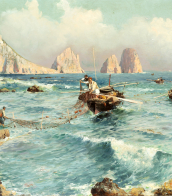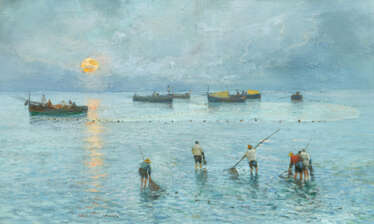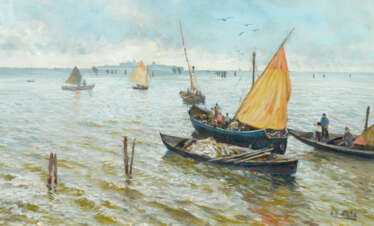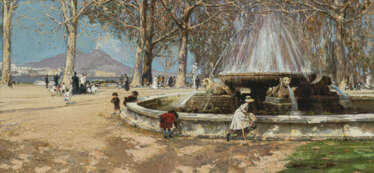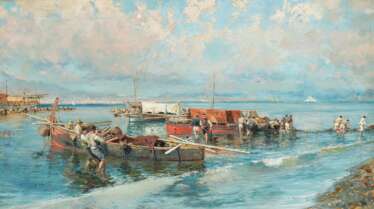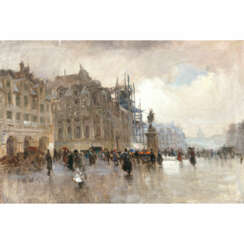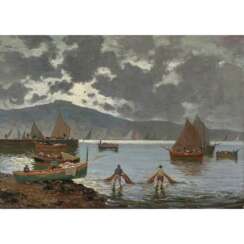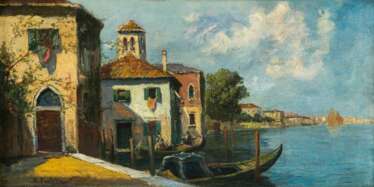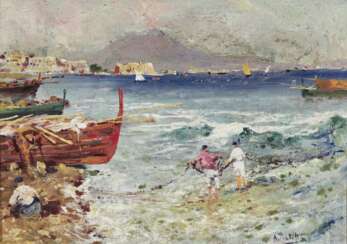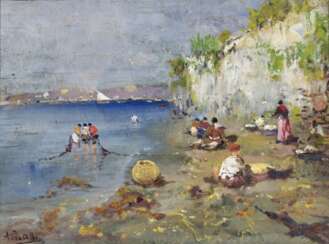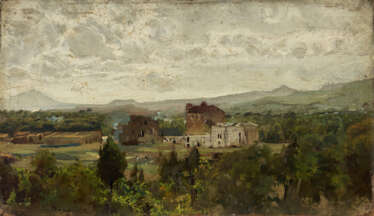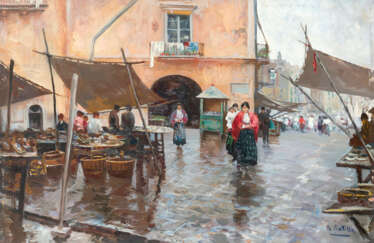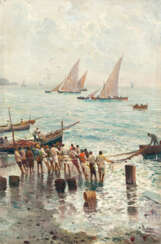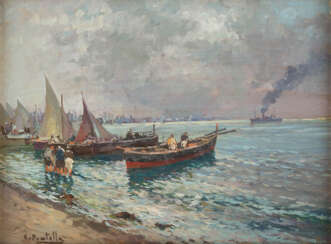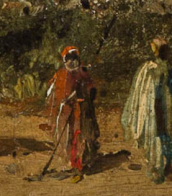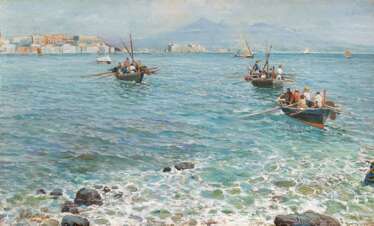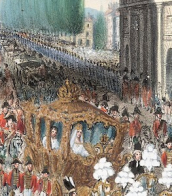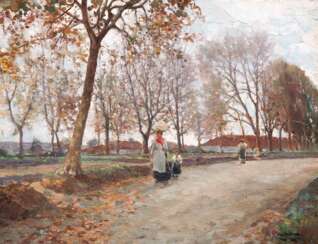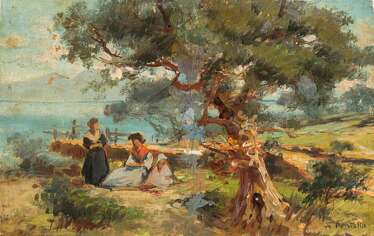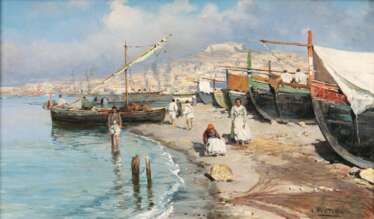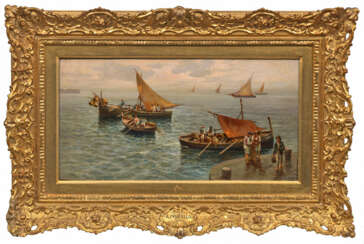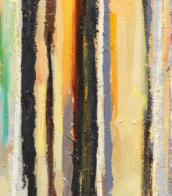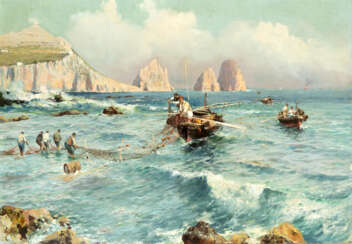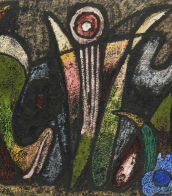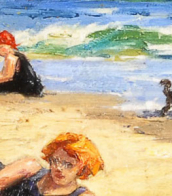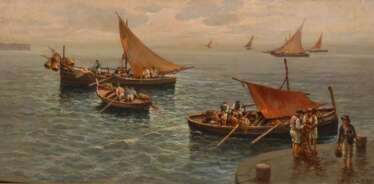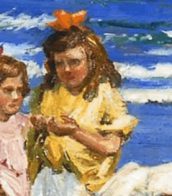attilio pratella (1856 - 1949)
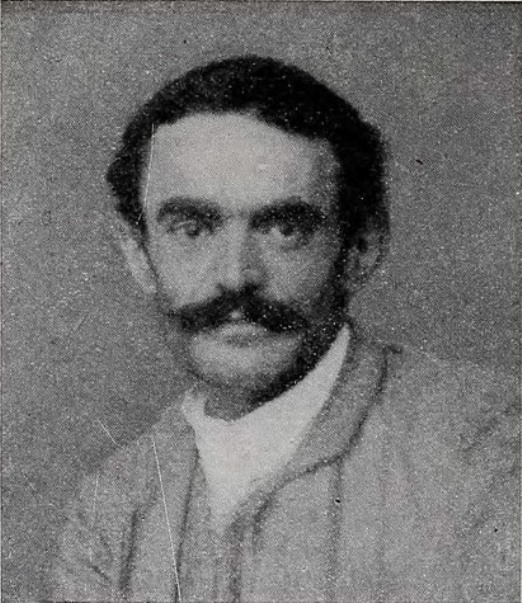
Attilio Pratella was an Italian marine and landscape painter.
Attilio Pratella received his first professional skills at the Trisi College, continued his studies at the Bologna Academy of Fine Arts and at the Academy of Fine Arts in Naples. His first paintings received positive feedback from the juries of exhibitions.
The artist executed miniature Neapolitan views for tourists and made sketches of paintings of products of the ceramic factory of the Cacciapoti brothers. After moving to the Neapolitan neighborhood of Vomero, Pratella began to paint views of the picturesque surroundings, the Gulf of Naples and Vesuvius. Soon a group of Vomeresi ("Vomeristi") formed around him, and the neighborhood where he lived gradually became an entire colony of artists.
In addition to Neapolitan landscapes, the artist created cityscapes of Paris and other European cities. In 1899 Attilio Pratella participated in the Paris Salon and received great recognition. Today his works are in the collections of the Museo del Capodimonte and the Galleria dell'Arte Ricci Oddi.


Attilio Pratella was an Italian marine and landscape painter.
Attilio Pratella received his first professional skills at the Trisi College, continued his studies at the Bologna Academy of Fine Arts and at the Academy of Fine Arts in Naples. His first paintings received positive feedback from the juries of exhibitions.
The artist executed miniature Neapolitan views for tourists and made sketches of paintings of products of the ceramic factory of the Cacciapoti brothers. After moving to the Neapolitan neighborhood of Vomero, Pratella began to paint views of the picturesque surroundings, the Gulf of Naples and Vesuvius. Soon a group of Vomeresi ("Vomeristi") formed around him, and the neighborhood where he lived gradually became an entire colony of artists.
In addition to Neapolitan landscapes, the artist created cityscapes of Paris and other European cities. In 1899 Attilio Pratella participated in the Paris Salon and received great recognition. Today his works are in the collections of the Museo del Capodimonte and the Galleria dell'Arte Ricci Oddi.


Attilio Pratella was an Italian marine and landscape painter.
Attilio Pratella received his first professional skills at the Trisi College, continued his studies at the Bologna Academy of Fine Arts and at the Academy of Fine Arts in Naples. His first paintings received positive feedback from the juries of exhibitions.
The artist executed miniature Neapolitan views for tourists and made sketches of paintings of products of the ceramic factory of the Cacciapoti brothers. After moving to the Neapolitan neighborhood of Vomero, Pratella began to paint views of the picturesque surroundings, the Gulf of Naples and Vesuvius. Soon a group of Vomeresi ("Vomeristi") formed around him, and the neighborhood where he lived gradually became an entire colony of artists.
In addition to Neapolitan landscapes, the artist created cityscapes of Paris and other European cities. In 1899 Attilio Pratella participated in the Paris Salon and received great recognition. Today his works are in the collections of the Museo del Capodimonte and the Galleria dell'Arte Ricci Oddi.
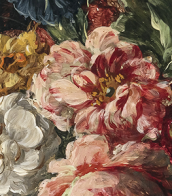

Attilio Pratella was an Italian marine and landscape painter.
Attilio Pratella received his first professional skills at the Trisi College, continued his studies at the Bologna Academy of Fine Arts and at the Academy of Fine Arts in Naples. His first paintings received positive feedback from the juries of exhibitions.
The artist executed miniature Neapolitan views for tourists and made sketches of paintings of products of the ceramic factory of the Cacciapoti brothers. After moving to the Neapolitan neighborhood of Vomero, Pratella began to paint views of the picturesque surroundings, the Gulf of Naples and Vesuvius. Soon a group of Vomeresi ("Vomeristi") formed around him, and the neighborhood where he lived gradually became an entire colony of artists.
In addition to Neapolitan landscapes, the artist created cityscapes of Paris and other European cities. In 1899 Attilio Pratella participated in the Paris Salon and received great recognition. Today his works are in the collections of the Museo del Capodimonte and the Galleria dell'Arte Ricci Oddi.


Attilio Pratella was an Italian marine and landscape painter.
Attilio Pratella received his first professional skills at the Trisi College, continued his studies at the Bologna Academy of Fine Arts and at the Academy of Fine Arts in Naples. His first paintings received positive feedback from the juries of exhibitions.
The artist executed miniature Neapolitan views for tourists and made sketches of paintings of products of the ceramic factory of the Cacciapoti brothers. After moving to the Neapolitan neighborhood of Vomero, Pratella began to paint views of the picturesque surroundings, the Gulf of Naples and Vesuvius. Soon a group of Vomeresi ("Vomeristi") formed around him, and the neighborhood where he lived gradually became an entire colony of artists.
In addition to Neapolitan landscapes, the artist created cityscapes of Paris and other European cities. In 1899 Attilio Pratella participated in the Paris Salon and received great recognition. Today his works are in the collections of the Museo del Capodimonte and the Galleria dell'Arte Ricci Oddi.
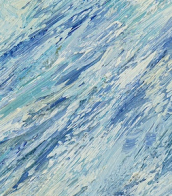

Attilio Pratella was an Italian marine and landscape painter.
Attilio Pratella received his first professional skills at the Trisi College, continued his studies at the Bologna Academy of Fine Arts and at the Academy of Fine Arts in Naples. His first paintings received positive feedback from the juries of exhibitions.
The artist executed miniature Neapolitan views for tourists and made sketches of paintings of products of the ceramic factory of the Cacciapoti brothers. After moving to the Neapolitan neighborhood of Vomero, Pratella began to paint views of the picturesque surroundings, the Gulf of Naples and Vesuvius. Soon a group of Vomeresi ("Vomeristi") formed around him, and the neighborhood where he lived gradually became an entire colony of artists.
In addition to Neapolitan landscapes, the artist created cityscapes of Paris and other European cities. In 1899 Attilio Pratella participated in the Paris Salon and received great recognition. Today his works are in the collections of the Museo del Capodimonte and the Galleria dell'Arte Ricci Oddi.
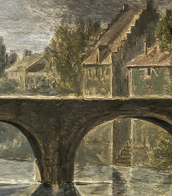

Attilio Pratella was an Italian marine and landscape painter.
Attilio Pratella received his first professional skills at the Trisi College, continued his studies at the Bologna Academy of Fine Arts and at the Academy of Fine Arts in Naples. His first paintings received positive feedback from the juries of exhibitions.
The artist executed miniature Neapolitan views for tourists and made sketches of paintings of products of the ceramic factory of the Cacciapoti brothers. After moving to the Neapolitan neighborhood of Vomero, Pratella began to paint views of the picturesque surroundings, the Gulf of Naples and Vesuvius. Soon a group of Vomeresi ("Vomeristi") formed around him, and the neighborhood where he lived gradually became an entire colony of artists.
In addition to Neapolitan landscapes, the artist created cityscapes of Paris and other European cities. In 1899 Attilio Pratella participated in the Paris Salon and received great recognition. Today his works are in the collections of the Museo del Capodimonte and the Galleria dell'Arte Ricci Oddi.
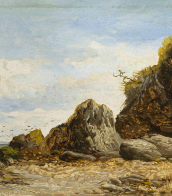

Attilio Pratella was an Italian marine and landscape painter.
Attilio Pratella received his first professional skills at the Trisi College, continued his studies at the Bologna Academy of Fine Arts and at the Academy of Fine Arts in Naples. His first paintings received positive feedback from the juries of exhibitions.
The artist executed miniature Neapolitan views for tourists and made sketches of paintings of products of the ceramic factory of the Cacciapoti brothers. After moving to the Neapolitan neighborhood of Vomero, Pratella began to paint views of the picturesque surroundings, the Gulf of Naples and Vesuvius. Soon a group of Vomeresi ("Vomeristi") formed around him, and the neighborhood where he lived gradually became an entire colony of artists.
In addition to Neapolitan landscapes, the artist created cityscapes of Paris and other European cities. In 1899 Attilio Pratella participated in the Paris Salon and received great recognition. Today his works are in the collections of the Museo del Capodimonte and the Galleria dell'Arte Ricci Oddi.
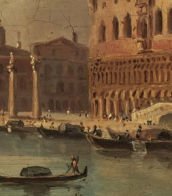

Attilio Pratella was an Italian marine and landscape painter.
Attilio Pratella received his first professional skills at the Trisi College, continued his studies at the Bologna Academy of Fine Arts and at the Academy of Fine Arts in Naples. His first paintings received positive feedback from the juries of exhibitions.
The artist executed miniature Neapolitan views for tourists and made sketches of paintings of products of the ceramic factory of the Cacciapoti brothers. After moving to the Neapolitan neighborhood of Vomero, Pratella began to paint views of the picturesque surroundings, the Gulf of Naples and Vesuvius. Soon a group of Vomeresi ("Vomeristi") formed around him, and the neighborhood where he lived gradually became an entire colony of artists.
In addition to Neapolitan landscapes, the artist created cityscapes of Paris and other European cities. In 1899 Attilio Pratella participated in the Paris Salon and received great recognition. Today his works are in the collections of the Museo del Capodimonte and the Galleria dell'Arte Ricci Oddi.


Attilio Pratella was an Italian marine and landscape painter.
Attilio Pratella received his first professional skills at the Trisi College, continued his studies at the Bologna Academy of Fine Arts and at the Academy of Fine Arts in Naples. His first paintings received positive feedback from the juries of exhibitions.
The artist executed miniature Neapolitan views for tourists and made sketches of paintings of products of the ceramic factory of the Cacciapoti brothers. After moving to the Neapolitan neighborhood of Vomero, Pratella began to paint views of the picturesque surroundings, the Gulf of Naples and Vesuvius. Soon a group of Vomeresi ("Vomeristi") formed around him, and the neighborhood where he lived gradually became an entire colony of artists.
In addition to Neapolitan landscapes, the artist created cityscapes of Paris and other European cities. In 1899 Attilio Pratella participated in the Paris Salon and received great recognition. Today his works are in the collections of the Museo del Capodimonte and the Galleria dell'Arte Ricci Oddi.
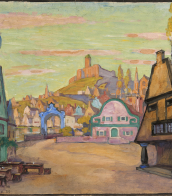

Attilio Pratella was an Italian marine and landscape painter.
Attilio Pratella received his first professional skills at the Trisi College, continued his studies at the Bologna Academy of Fine Arts and at the Academy of Fine Arts in Naples. His first paintings received positive feedback from the juries of exhibitions.
The artist executed miniature Neapolitan views for tourists and made sketches of paintings of products of the ceramic factory of the Cacciapoti brothers. After moving to the Neapolitan neighborhood of Vomero, Pratella began to paint views of the picturesque surroundings, the Gulf of Naples and Vesuvius. Soon a group of Vomeresi ("Vomeristi") formed around him, and the neighborhood where he lived gradually became an entire colony of artists.
In addition to Neapolitan landscapes, the artist created cityscapes of Paris and other European cities. In 1899 Attilio Pratella participated in the Paris Salon and received great recognition. Today his works are in the collections of the Museo del Capodimonte and the Galleria dell'Arte Ricci Oddi.
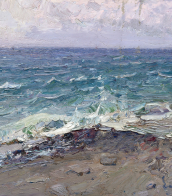

Attilio Pratella was an Italian marine and landscape painter.
Attilio Pratella received his first professional skills at the Trisi College, continued his studies at the Bologna Academy of Fine Arts and at the Academy of Fine Arts in Naples. His first paintings received positive feedback from the juries of exhibitions.
The artist executed miniature Neapolitan views for tourists and made sketches of paintings of products of the ceramic factory of the Cacciapoti brothers. After moving to the Neapolitan neighborhood of Vomero, Pratella began to paint views of the picturesque surroundings, the Gulf of Naples and Vesuvius. Soon a group of Vomeresi ("Vomeristi") formed around him, and the neighborhood where he lived gradually became an entire colony of artists.
In addition to Neapolitan landscapes, the artist created cityscapes of Paris and other European cities. In 1899 Attilio Pratella participated in the Paris Salon and received great recognition. Today his works are in the collections of the Museo del Capodimonte and the Galleria dell'Arte Ricci Oddi.


Attilio Pratella was an Italian marine and landscape painter.
Attilio Pratella received his first professional skills at the Trisi College, continued his studies at the Bologna Academy of Fine Arts and at the Academy of Fine Arts in Naples. His first paintings received positive feedback from the juries of exhibitions.
The artist executed miniature Neapolitan views for tourists and made sketches of paintings of products of the ceramic factory of the Cacciapoti brothers. After moving to the Neapolitan neighborhood of Vomero, Pratella began to paint views of the picturesque surroundings, the Gulf of Naples and Vesuvius. Soon a group of Vomeresi ("Vomeristi") formed around him, and the neighborhood where he lived gradually became an entire colony of artists.
In addition to Neapolitan landscapes, the artist created cityscapes of Paris and other European cities. In 1899 Attilio Pratella participated in the Paris Salon and received great recognition. Today his works are in the collections of the Museo del Capodimonte and the Galleria dell'Arte Ricci Oddi.
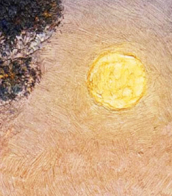

Attilio Pratella was an Italian marine and landscape painter.
Attilio Pratella received his first professional skills at the Trisi College, continued his studies at the Bologna Academy of Fine Arts and at the Academy of Fine Arts in Naples. His first paintings received positive feedback from the juries of exhibitions.
The artist executed miniature Neapolitan views for tourists and made sketches of paintings of products of the ceramic factory of the Cacciapoti brothers. After moving to the Neapolitan neighborhood of Vomero, Pratella began to paint views of the picturesque surroundings, the Gulf of Naples and Vesuvius. Soon a group of Vomeresi ("Vomeristi") formed around him, and the neighborhood where he lived gradually became an entire colony of artists.
In addition to Neapolitan landscapes, the artist created cityscapes of Paris and other European cities. In 1899 Attilio Pratella participated in the Paris Salon and received great recognition. Today his works are in the collections of the Museo del Capodimonte and the Galleria dell'Arte Ricci Oddi.
